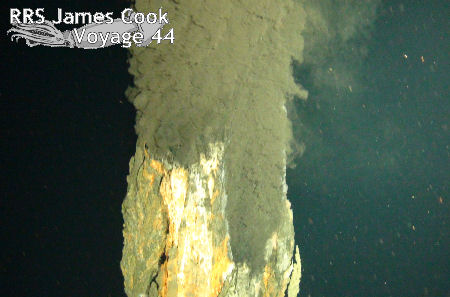Sunday 11th April
You may have been wondering what HyBIS has been up to over the past few days. Well, we had to keep quiet about it while our institutes back home could send out a press release - but on Tuesday night, we succeeded in finding the deepest hydrothermal vent known so far, at 4960 metres deep.
After five hours surveying the seafloor in an area highlighted by an earlier Autosub6000 mission, HyBIS came across rust-coloured blocks of sulphide on the seafloor, which told us that the vents were nearby. After a little further exploration, a tremendous roar went up in the main lab as a beautiful cluster of black smokers came into camera view. It was an amazing feeling to know that in a world with more than six billion people, we were seeing part of our planet that no-one had ever seen before (and now you can too, through the video below).
Finding these vents is the culmination of combined efforts by all our team working together on board - scientists, engineers, ship's crew - and colleagues ashore. Below is an extract from the press release. In our diary tomorrow we'll talk about the discovery in more detail - and what HyBIS has been doing since...
Scientific expedition discovers world's deepest known undersea volcanic vents
A British scientific expedition has discovered the world's deepest undersea volcanic vents, known as 'black smokers', 3.1 miles (5000 metres) down in the Cayman Trough in the Caribbean. Using a deep-diving vehicle remotely controlled from the Royal Research Ship James Cook, the scientists found slender spires made of copper and iron ores on the seafloor, erupting water hot enough to melt lead, nearly half a mile deeper than anyone has seen before.
"Seeing the world's deepest black-smoker vents looming out of the darkness was awe-inspiring," says Jon Copley, a marine biologist at the University of Southampton's School of Ocean and Earth Science (SOES) and leader of the overall research programme. "Superheated water was gushing out of their two-storey high mineral spires, more than three miles deep beneath the waves".
"We hope our discovery will yield new insights into biogeochemically important elements in one of the most extreme naturally occurring environments on our planet," says geochemist Doug Connelly of the UK National Oceanography Centre (NOC) in Southampton, who is the leader of the expedition.
"It was like wandering across the surface of another world," says geologist Bramley Murton of the NOC, who piloted the HyBIS underwater vehicle around the world's deepest volcanic vents for the first time. "The rainbow hues of the mineral spires and the fluorescent blues of the microbial mats covering them were like nothing I had ever seen before."



